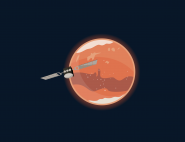Geologic and spectral mapping of etched terrain deposits in northern Meridiani Planum
Griffes, J. L.; Arvidson, R. E.; Poulet, F.; Gendrin, A.
Journal of Geophysical Research E: Planets
Summary: A ~1 km vertical section of etched terrain and hematite-bearing plains materials and nearby cratered terrain surfaces was mapped in the northern portion of Meridiani Planum using MOC, THEMIS, MOLA, and OMEGA data. The oldest materials are the cratered plains, which have 0.4 to 2.5 µm spectral reflectance dominated by a mix of low and high calcium pyroxenes. Etched plains materials overlie this unit and are exposed within a 120 km NW-SE trending valley to the south of the cratered plains. Lower etched plains materials exhibit a kieserite signature on a plateau-forming horizon and polyhydrated sulfate signatures on the main valley floor. The upper etched plains unit exhibits signatures consistent with hydrated iron oxides and is covered by what is interpreted to be a relatively thin layer of basaltic sand and hematitic concretions (the hematite-bearing plains unit). The youngest unit consists of ejecta deposits from a cluster of six craters that mantle the eastern portion of the study area. The thick section of etched plains materials (~900 m) with exposures of hydrated sulfates and hydrated iron oxides implies that measurements made by the Opportunity rover (located ~390 km to the southwest of the study area) are at the top of an extensive section of layered sedimentary materials formed in and/or altered in an aqueous environment and exposed by aeolian erosion.


